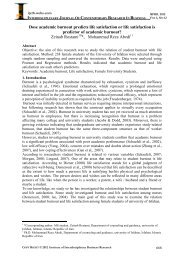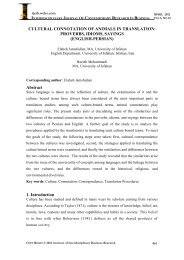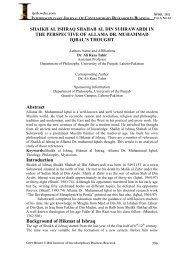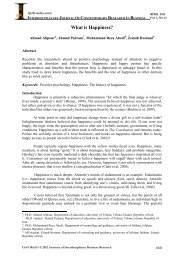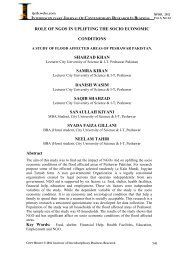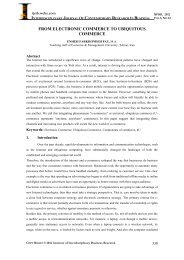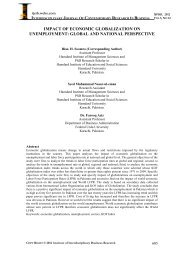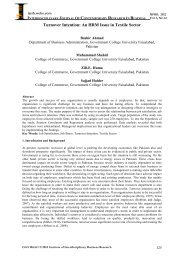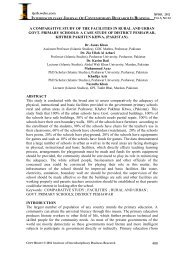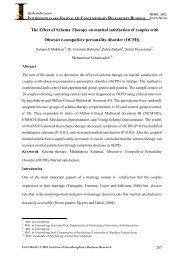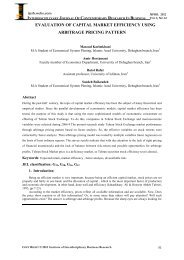The effects of informal groups on organizational - journal ...
The effects of informal groups on organizational - journal ...
The effects of informal groups on organizational - journal ...
You also want an ePaper? Increase the reach of your titles
YUMPU automatically turns print PDFs into web optimized ePapers that Google loves.
ijcrb.webs.comINTERDISCIPLINARY JOURNAL OF CONTEMPORARY RESEARCH IN BUSINESSAPRIL 2012VOL 3, NO 12THE EFFECTS OF INFORMAL GROUPS ON ORGANIZATIONALPERFORMANCE: A CASE STUDY OF IRANAuthors:Author’s names and affiliati<strong>on</strong>s:Farveh Farivar (corresp<strong>on</strong>ding author)Part Time Lecturer: Attar Institute <str<strong>on</strong>g>of</str<strong>on</strong>g> Higher Educati<strong>on</strong>Postal address: No 84, Farhad 7, Farhad St, Malekabad Blvd, Mashhad, IranOsveh EsmaeelinezhadPhD studentUniversity <str<strong>on</strong>g>of</str<strong>on</strong>g> MalaysiaPostal address: 107-24-03, Bistari c<strong>on</strong>do, Jalan 1/64 D, <str<strong>on</strong>g>of</str<strong>on</strong>g>f Jalan Putra, K50350, kualalumpour, MalaysiaAbstract:Informal <str<strong>on</strong>g>groups</str<strong>on</strong>g> form within formal systems and their activities have an undeniableimpact <strong>on</strong> organizati<strong>on</strong>s’ progress. Nevertheless, managers sometimes fail to realize thepressures <str<strong>on</strong>g>of</str<strong>on</strong>g> <str<strong>on</strong>g>informal</str<strong>on</strong>g> <str<strong>on</strong>g>groups</str<strong>on</strong>g> that influence and regulate individuals’ behavior. Thisstudy examines the impact <str<strong>on</strong>g>of</str<strong>on</strong>g> <str<strong>on</strong>g>informal</str<strong>on</strong>g> <str<strong>on</strong>g>groups</str<strong>on</strong>g> <strong>on</strong> the organizati<strong>on</strong>al performance.Although previous studies emphasized <strong>on</strong> the importance <str<strong>on</strong>g>of</str<strong>on</strong>g> formal employeeinvolvement, the way in which <str<strong>on</strong>g>informal</str<strong>on</strong>g> <str<strong>on</strong>g>groups</str<strong>on</strong>g> influence organizati<strong>on</strong>al performanceremains obscure. In this study, methodology was survey. Two questi<strong>on</strong>naires weredesigned that the first <strong>on</strong>e determined the benefits resulted from <str<strong>on</strong>g>informal</str<strong>on</strong>g> <str<strong>on</strong>g>groups</str<strong>on</strong>g> and thesec<strong>on</strong>d <strong>on</strong>e evaluated the <str<strong>on</strong>g>effects</str<strong>on</strong>g> <str<strong>on</strong>g>of</str<strong>on</strong>g> these benefits <strong>on</strong> organizati<strong>on</strong>al performance. Toestimate the organizati<strong>on</strong>al performance, the Based scorecard model <str<strong>on</strong>g>of</str<strong>on</strong>g> Kaplan wasused. A sample drawn from Iranian IT companies answered to the questi<strong>on</strong>naires anddata were analyzed by chi-square and normal test. Total result <str<strong>on</strong>g>of</str<strong>on</strong>g> study displays thepositive <str<strong>on</strong>g>effects</str<strong>on</strong>g> <str<strong>on</strong>g>of</str<strong>on</strong>g> <str<strong>on</strong>g>informal</str<strong>on</strong>g> <str<strong>on</strong>g>groups</str<strong>on</strong>g> <strong>on</strong> organizati<strong>on</strong>al performance.Key words: Informal group, formal group, organizati<strong>on</strong>al performance, Basedscorecard modelCOPY RIGHT © 2012 Institute <str<strong>on</strong>g>of</str<strong>on</strong>g> Interdisciplinary Business Research 364
ijcrb.webs.comINTERDISCIPLINARY JOURNAL OF CONTEMPORARY RESEARCH IN BUSINESSAPRIL 2012VOL 3, NO 121. Introducti<strong>on</strong>:Rapid developments <str<strong>on</strong>g>of</str<strong>on</strong>g> technology and dynamic envir<strong>on</strong>ment have increased the role <str<strong>on</strong>g>of</str<strong>on</strong>g>human resource as a capital for organizati<strong>on</strong>s’ competitive advantage. Employees andorganizati<strong>on</strong>s establish communicati<strong>on</strong>s with each other that are not formed or designedby <str<strong>on</strong>g>of</str<strong>on</strong>g>ficial systems to various causes such as comm<strong>on</strong> interests and goals. <str<strong>on</strong>g>The</str<strong>on</strong>g>se kinds<str<strong>on</strong>g>of</str<strong>on</strong>g> communicati<strong>on</strong>s are self-created and independent <str<strong>on</strong>g>of</str<strong>on</strong>g> formal channel.Organizati<strong>on</strong>s create a formal net <str<strong>on</strong>g>of</str<strong>on</strong>g> communicati<strong>on</strong> which determines the line <str<strong>on</strong>g>of</str<strong>on</strong>g>authority and activities to achieve organizati<strong>on</strong>al goals. According to Krackhardt andHans<strong>on</strong> (1993) formal <str<strong>on</strong>g>groups</str<strong>on</strong>g> have public identity so are recognized by management.Previous surveys menti<strong>on</strong>ed positive <str<strong>on</strong>g>effects</str<strong>on</strong>g> <str<strong>on</strong>g>of</str<strong>on</strong>g> group-building and team working <strong>on</strong>organizati<strong>on</strong>s. For instance, Driskell and Salas (1992) argued <str<strong>on</strong>g>groups</str<strong>on</strong>g> can solve problemfaster and improve efficiency. <str<strong>on</strong>g>The</str<strong>on</strong>g>refore, the attenti<strong>on</strong> <str<strong>on</strong>g>of</str<strong>on</strong>g> management to formal <str<strong>on</strong>g>groups</str<strong>on</strong>g>has increased radically. C<strong>on</strong>troversially, <str<strong>on</strong>g>informal</str<strong>on</strong>g> <str<strong>on</strong>g>groups</str<strong>on</strong>g> form within formal systemsand rising sp<strong>on</strong>taneously as people work together. Informal <str<strong>on</strong>g>groups</str<strong>on</strong>g> are built <strong>on</strong> the base<str<strong>on</strong>g>of</str<strong>on</strong>g> comm<strong>on</strong> interests and friendship without management c<strong>on</strong>trol. Although <str<strong>on</strong>g>informal</str<strong>on</strong>g><str<strong>on</strong>g>groups</str<strong>on</strong>g> play important roles in organizati<strong>on</strong>s, managers sometimes fail to realize thatthere are <str<strong>on</strong>g>of</str<strong>on</strong>g>ten <str<strong>on</strong>g>informal</str<strong>on</strong>g> group pressures within every organizati<strong>on</strong> which influence anddetermine employees’ behavior.Informal <str<strong>on</strong>g>groups</str<strong>on</strong>g> formulate implied codes <str<strong>on</strong>g>of</str<strong>on</strong>g> moral rules and establish behavioralstandards un<str<strong>on</strong>g>of</str<strong>on</strong>g>ficially in organizati<strong>on</strong>s. <str<strong>on</strong>g>The</str<strong>on</strong>g> approaches toward <str<strong>on</strong>g>informal</str<strong>on</strong>g> <str<strong>on</strong>g>groups</str<strong>on</strong>g> arevaried in the different level <str<strong>on</strong>g>of</str<strong>on</strong>g> analysis. At the individual level, based <strong>on</strong> social c<strong>on</strong>troltheory, group norms c<strong>on</strong>trol people by creating group cohesiveness so competencyperformancerelati<strong>on</strong>ship would weaken. On the c<strong>on</strong>trary, at the group level analysis,synergistic interacti<strong>on</strong> am<strong>on</strong>g group’s members creates high level <str<strong>on</strong>g>of</str<strong>on</strong>g> performance(Barrick et al, 1998). By the way, the formati<strong>on</strong> <str<strong>on</strong>g>of</str<strong>on</strong>g> <str<strong>on</strong>g>informal</str<strong>on</strong>g> <str<strong>on</strong>g>groups</str<strong>on</strong>g> is inevitable and itwould be difficult for organizati<strong>on</strong> to forbid <str<strong>on</strong>g>informal</str<strong>on</strong>g> working relati<strong>on</strong>ships to arise.Gulati and Puranam stated some external c<strong>on</strong>diti<strong>on</strong>s which are largely out <str<strong>on</strong>g>of</str<strong>on</strong>g> c<strong>on</strong>trolinfluence the relati<strong>on</strong>ship between formal and <str<strong>on</strong>g>informal</str<strong>on</strong>g> <str<strong>on</strong>g>groups</str<strong>on</strong>g> into an organizati<strong>on</strong>.Although c<strong>on</strong>siderable research has provided str<strong>on</strong>g support <strong>on</strong> the linkage betweenorganizati<strong>on</strong>al performance and formal group, there are notable gaps in the literature <strong>on</strong>the empirical examinati<strong>on</strong> <str<strong>on</strong>g>of</str<strong>on</strong>g> whether or not <str<strong>on</strong>g>informal</str<strong>on</strong>g> <str<strong>on</strong>g>groups</str<strong>on</strong>g> would affectorganizati<strong>on</strong>al performance positively, especially in developing countries. Since cultureis the base <str<strong>on</strong>g>of</str<strong>on</strong>g> group’s behavior and form the way that they interact with each other andorganizati<strong>on</strong> (Willcoxs<strong>on</strong> & Millett, 2000), the impacts <str<strong>on</strong>g>of</str<strong>on</strong>g> group can be various fromcountry to another <strong>on</strong>e so more research <strong>on</strong> <str<strong>on</strong>g>groups</str<strong>on</strong>g> in developing countries seemsessential to reach a better understanding <str<strong>on</strong>g>of</str<strong>on</strong>g> their <str<strong>on</strong>g>effects</str<strong>on</strong>g>.<str<strong>on</strong>g>The</str<strong>on</strong>g> major aim <str<strong>on</strong>g>of</str<strong>on</strong>g> this paper is to explore the impact <str<strong>on</strong>g>of</str<strong>on</strong>g> <str<strong>on</strong>g>informal</str<strong>on</strong>g> <str<strong>on</strong>g>groups</str<strong>on</strong>g> <strong>on</strong>organizati<strong>on</strong>al performance. To reach this purpose, the study was divided in three steps.Firstly, the <str<strong>on</strong>g>effects</str<strong>on</strong>g> <str<strong>on</strong>g>of</str<strong>on</strong>g> <str<strong>on</strong>g>informal</str<strong>on</strong>g> <str<strong>on</strong>g>groups</str<strong>on</strong>g> <strong>on</strong> organizati<strong>on</strong>s have been drawn by literaturereview and the accuracy <str<strong>on</strong>g>of</str<strong>on</strong>g> these <str<strong>on</strong>g>effects</str<strong>on</strong>g> was examined. Sec<strong>on</strong>dly, according to balancedscorecard model <str<strong>on</strong>g>of</str<strong>on</strong>g> Kaplan and Nort<strong>on</strong> (1996), the indicators <str<strong>on</strong>g>of</str<strong>on</strong>g> organizati<strong>on</strong>alperformance were chosen. Finally the impacts <str<strong>on</strong>g>of</str<strong>on</strong>g> <str<strong>on</strong>g>informal</str<strong>on</strong>g> group’s <str<strong>on</strong>g>effects</str<strong>on</strong>g> <strong>on</strong> four-sidedprism <str<strong>on</strong>g>of</str<strong>on</strong>g> BSC model were investigated by questi<strong>on</strong>naire in a sample <str<strong>on</strong>g>of</str<strong>on</strong>g> IT industry inIran.COPY RIGHT © 2012 Institute <str<strong>on</strong>g>of</str<strong>on</strong>g> Interdisciplinary Business Research 365
ijcrb.webs.comINTERDISCIPLINARY JOURNAL OF CONTEMPORARY RESEARCH IN BUSINESSAPRIL 2012VOL 3, NO 122. Literature review:2.1. Informal group and organizati<strong>on</strong>al performance:Blau and Scott (1962) declared that employees usually do not accomplish their duties byall <str<strong>on</strong>g>of</str<strong>on</strong>g> their power because formal authority <str<strong>on</strong>g>of</str<strong>on</strong>g>ten cannot motivate employeescompletely. Additi<strong>on</strong>ally, formal authority has forced employees to show certainbehaviors standardized by regulati<strong>on</strong>s so they c<strong>on</strong>tract their efforts and avoid beinginnovative and creative. On the other hand, <str<strong>on</strong>g>informal</str<strong>on</strong>g> organizati<strong>on</strong>s are the interlockingsocial structure created to answer employees’ social and psychological needs becausepeople need to feel they are part <str<strong>on</strong>g>of</str<strong>on</strong>g> something.Organizati<strong>on</strong>al sociologists count several reas<strong>on</strong>s why <str<strong>on</strong>g>informal</str<strong>on</strong>g> <str<strong>on</strong>g>groups</str<strong>on</strong>g> form. M<strong>on</strong>geand Eisenberg (1987) discussed <str<strong>on</strong>g>informal</str<strong>on</strong>g> <str<strong>on</strong>g>groups</str<strong>on</strong>g> pop out when people try to express<str<strong>on</strong>g>effects</str<strong>on</strong>g>, influence attempt, and exchange informati<strong>on</strong> or services. Some researchers haveidentified some psychological reas<strong>on</strong>s for the existence <str<strong>on</strong>g>of</str<strong>on</strong>g> <str<strong>on</strong>g>informal</str<strong>on</strong>g> networks such asaffiliati<strong>on</strong> needs, the sense <str<strong>on</strong>g>of</str<strong>on</strong>g> identity, social reality, and defense mechanism (Baker,1981; Han, 1983). Waldstrom (2001) have classified the reas<strong>on</strong>s why employees engagein <str<strong>on</strong>g>informal</str<strong>on</strong>g> <str<strong>on</strong>g>groups</str<strong>on</strong>g> into three categories: (1) technical reas<strong>on</strong>s related to work issues, (2)political reas<strong>on</strong>s related to individual and group goals, and (3) cultural approaches. Inadditi<strong>on</strong>, Crampt<strong>on</strong> and Hodge (1998) indicated that <str<strong>on</strong>g>informal</str<strong>on</strong>g> structures can satisfy theneed <str<strong>on</strong>g>of</str<strong>on</strong>g> knowing by their faster and less cumbersome communicati<strong>on</strong> network. Someothers stated that people seek benefits so individuals might join an <str<strong>on</strong>g>informal</str<strong>on</strong>g> group to useits power to bias colleagues or superiors in order to obtain an advantage (Waldstrom,2001).Overriding factor that creates an <str<strong>on</strong>g>informal</str<strong>on</strong>g> group is friendship or comm<strong>on</strong> interest butthe role <str<strong>on</strong>g>of</str<strong>on</strong>g> members is not the same into an <str<strong>on</strong>g>informal</str<strong>on</strong>g> network. Stephens<strong>on</strong> (1998)categorized three kinds <str<strong>on</strong>g>of</str<strong>on</strong>g> roles in <str<strong>on</strong>g>groups</str<strong>on</strong>g> by focusing <strong>on</strong> the flow <str<strong>on</strong>g>of</str<strong>on</strong>g> informati<strong>on</strong> in thegroup: (1) Hubs; people who are most c<strong>on</strong>nected with others, (2) Gatekeepers; transportinformati<strong>on</strong> between hubs, and (3) Pulse takers; they influence how other membersperceive the informati<strong>on</strong>. Moreover, she believes that <str<strong>on</strong>g>informal</str<strong>on</strong>g> networks are the initialstage <str<strong>on</strong>g>of</str<strong>on</strong>g> organizati<strong>on</strong>al structure and have hierarchical development which set its ownorganizing principles. This kind <str<strong>on</strong>g>of</str<strong>on</strong>g> classificati<strong>on</strong> and argument dem<strong>on</strong>strate that theimportance and effect <str<strong>on</strong>g>of</str<strong>on</strong>g> members are different so the c<strong>on</strong>cept <str<strong>on</strong>g>of</str<strong>on</strong>g> <str<strong>on</strong>g>informal</str<strong>on</strong>g> leaders wascreated. Although, Informal leaders have not legislative power <str<strong>on</strong>g>of</str<strong>on</strong>g> hiring and firingemployees, they are followed by members because <str<strong>on</strong>g>of</str<strong>on</strong>g> their inspiring and moral <str<strong>on</strong>g>effects</str<strong>on</strong>g>.Some studies reveal that <str<strong>on</strong>g>informal</str<strong>on</strong>g> leaders have a str<strong>on</strong>g influence <strong>on</strong> group operati<strong>on</strong>sand outcomes (Pescosolido, 2001) so it is not questi<strong>on</strong>able to c<strong>on</strong>sider them as a source<str<strong>on</strong>g>of</str<strong>on</strong>g> power beside formal authority. <str<strong>on</strong>g>The</str<strong>on</strong>g>refore, there are c<strong>on</strong>troversy surroundingswhether <str<strong>on</strong>g>informal</str<strong>on</strong>g> <str<strong>on</strong>g>groups</str<strong>on</strong>g> are positive entities in organizati<strong>on</strong>s.<str<strong>on</strong>g>The</str<strong>on</strong>g>re is a plethora <str<strong>on</strong>g>of</str<strong>on</strong>g> debates dem<strong>on</strong>strating <str<strong>on</strong>g>groups</str<strong>on</strong>g> have a str<strong>on</strong>g effect <strong>on</strong>organizati<strong>on</strong>al effectiveness by influencing <strong>on</strong> both employees and superiors’ functi<strong>on</strong>s.First <str<strong>on</strong>g>of</str<strong>on</strong>g> all, according to the social identity theory, employees would be satisfied by thesense <str<strong>on</strong>g>of</str<strong>on</strong>g> bel<strong>on</strong>ging which stimulates the process <str<strong>on</strong>g>of</str<strong>on</strong>g> motivati<strong>on</strong> and improve self-esteem,resulting in high level <str<strong>on</strong>g>of</str<strong>on</strong>g> performance (Gary, 1996; Smith, 2008). Sec<strong>on</strong>dly, formalcommunicati<strong>on</strong> arranged by management are likely unidirecti<strong>on</strong>al and underprivilegedwhile <str<strong>on</strong>g>informal</str<strong>on</strong>g> <str<strong>on</strong>g>groups</str<strong>on</strong>g> use <str<strong>on</strong>g>informal</str<strong>on</strong>g> communicati<strong>on</strong> net that is sp<strong>on</strong>taneous, interactive, andmore effective because <str<strong>on</strong>g>of</str<strong>on</strong>g> the lack <str<strong>on</strong>g>of</str<strong>on</strong>g> pre-specificati<strong>on</strong> (Ouchi, 1980; Kraut et al, 2002).Sp<strong>on</strong>taneously, group awareness increases when the sharing <str<strong>on</strong>g>of</str<strong>on</strong>g> informati<strong>on</strong> increases soCOPY RIGHT © 2012 Institute <str<strong>on</strong>g>of</str<strong>on</strong>g> Interdisciplinary Business Research 366
ijcrb.webs.comINTERDISCIPLINARY JOURNAL OF CONTEMPORARY RESEARCH IN BUSINESSAPRIL 2012VOL 3, NO 123. Research Hypotheses and methodology:In this study, the research methodology was survey and data were gathered byquesti<strong>on</strong>naire and interview. <str<strong>on</strong>g>The</str<strong>on</strong>g> main hypothesis is:Main Hypothesis: <str<strong>on</strong>g>The</str<strong>on</strong>g> existence <str<strong>on</strong>g>of</str<strong>on</strong>g> <str<strong>on</strong>g>informal</str<strong>on</strong>g> <str<strong>on</strong>g>groups</str<strong>on</strong>g> has a positive effect <strong>on</strong>organizati<strong>on</strong>al performanceTo evaluate organizati<strong>on</strong>al performance, Based Scorecard model was adopted as thebasis <str<strong>on</strong>g>of</str<strong>on</strong>g> instrumentati<strong>on</strong> for this study. This model introduced by Kaplan and Mort<strong>on</strong> in1992 and has been modified several times by them to masseur organizati<strong>on</strong>alperformance and strategic objectives and strategy maps (Kaplan, 2010). <str<strong>on</strong>g>The</str<strong>on</strong>g> modelc<strong>on</strong>sists <str<strong>on</strong>g>of</str<strong>on</strong>g> four perspectives: (1) Financial c<strong>on</strong>sisted <str<strong>on</strong>g>of</str<strong>on</strong>g> cost structure and pr<str<strong>on</strong>g>of</str<strong>on</strong>g>itabilityand measured by residual income (2) Customer comprised <str<strong>on</strong>g>of</str<strong>on</strong>g> product-service attributesand market share indexes (3) Process included operati<strong>on</strong> management process, customermanagement process, innovati<strong>on</strong> process, and regulatory and social process thatcalculated by productivity, product leadership, and public resp<strong>on</strong>sibility, and finally (4)Learning and growth with metrics pers<strong>on</strong>nel development, employee attitudes, andbalance between short-range and l<strong>on</strong>g-range objectives.Because <str<strong>on</strong>g>of</str<strong>on</strong>g> some limitati<strong>on</strong>s the study does not cover financial dimensi<strong>on</strong> so accordingto the other perspectives three alternative hypotheses are c<strong>on</strong>sidered:Hypothesis 1: <str<strong>on</strong>g>The</str<strong>on</strong>g> existence <str<strong>on</strong>g>of</str<strong>on</strong>g> <str<strong>on</strong>g>informal</str<strong>on</strong>g> <str<strong>on</strong>g>groups</str<strong>on</strong>g> has a positive effect <strong>on</strong> the customersatisfacti<strong>on</strong>Hypothesis 2: <str<strong>on</strong>g>The</str<strong>on</strong>g> existence <str<strong>on</strong>g>of</str<strong>on</strong>g> <str<strong>on</strong>g>informal</str<strong>on</strong>g> <str<strong>on</strong>g>groups</str<strong>on</strong>g> has a positive effect <strong>on</strong> processHypothesis 3: <str<strong>on</strong>g>The</str<strong>on</strong>g> existence <str<strong>on</strong>g>of</str<strong>on</strong>g> <str<strong>on</strong>g>informal</str<strong>on</strong>g> <str<strong>on</strong>g>groups</str<strong>on</strong>g> has a positive effect <strong>on</strong> employees’learning and growth<str<strong>on</strong>g>The</str<strong>on</strong>g> research focused <strong>on</strong> IT industry <str<strong>on</strong>g>of</str<strong>on</strong>g> Iran and sampling was c<strong>on</strong>ducted at the biggestIranian IT company c<strong>on</strong>sists <str<strong>on</strong>g>of</str<strong>on</strong>g> 26 main firms and 20 Subsidiary firms scatteredthroughout Iran. <str<strong>on</strong>g>The</str<strong>on</strong>g> company has 600 full time employees so 320 questi<strong>on</strong>naires sentout and 290 questi<strong>on</strong>naires were thoroughly completed and returned.To design main questi<strong>on</strong>naire, at first, a random sample including 25 employees andmanagers were interviewed to determine how they express their opini<strong>on</strong> to the <str<strong>on</strong>g>effects</str<strong>on</strong>g> <str<strong>on</strong>g>of</str<strong>on</strong>g><str<strong>on</strong>g>informal</str<strong>on</strong>g> <str<strong>on</strong>g>groups</str<strong>on</strong>g>. Eight factors were menti<strong>on</strong>ed by resp<strong>on</strong>dents as the most importantadvantages <str<strong>on</strong>g>of</str<strong>on</strong>g> <str<strong>on</strong>g>informal</str<strong>on</strong>g> <str<strong>on</strong>g>groups</str<strong>on</strong>g> which are displayed in table 1:Table 1: <str<strong>on</strong>g>The</str<strong>on</strong>g> benefits <str<strong>on</strong>g>of</str<strong>on</strong>g> <str<strong>on</strong>g>informal</str<strong>on</strong>g> <str<strong>on</strong>g>groups</str<strong>on</strong>g> according to the resp<strong>on</strong>dentsFactors n Frequency (F) f % RankingImproving motivati<strong>on</strong> 25 21 84 1Job security 25 19 76 2Enhancing involvement 25 18 72 3Innovati<strong>on</strong> 25 16 64 4Modifying job problems 25 15 60 5<str<strong>on</strong>g>The</str<strong>on</strong>g> sense <str<strong>on</strong>g>of</str<strong>on</strong>g> identity 25 12 48 6Improving communicati<strong>on</strong> 25 11 44 7Developing efficiency 25 8 32 8COPY RIGHT © 2012 Institute <str<strong>on</strong>g>of</str<strong>on</strong>g> Interdisciplinary Business Research 368
ijcrb.webs.comINTERDISCIPLINARY JOURNAL OF CONTEMPORARY RESEARCH IN BUSINESSAPRIL 2012VOL 3, NO 12Sec<strong>on</strong>dly, to make sure that these factors were selected correctly, a five point scalequesti<strong>on</strong>naire was designed and given to employees. <str<strong>on</strong>g>The</str<strong>on</strong>g>n, the result was analyzed bynormal distributi<strong>on</strong> test at the significance level <str<strong>on</strong>g>of</str<strong>on</strong>g> α = 0.05H0: µ ≤3H1: µ≥3Since z-statistic was 8.71 and the z-table was 1.645 so z falls in the rejecti<strong>on</strong> regi<strong>on</strong> andnull hypothesis can be rejected at this level <str<strong>on</strong>g>of</str<strong>on</strong>g> c<strong>on</strong>fidence. <str<strong>on</strong>g>The</str<strong>on</strong>g>refore, these eight factorswere chosen correctly as the advantages <str<strong>on</strong>g>of</str<strong>on</strong>g> <str<strong>on</strong>g>informal</str<strong>on</strong>g> <str<strong>on</strong>g>groups</str<strong>on</strong>g> in this study. <str<strong>on</strong>g>The</str<strong>on</strong>g>c<strong>on</strong>ceptual model is illustrated in figure below:Figure (1): C<strong>on</strong>ceptual frameworkMotivati<strong>on</strong>Job securityInformal groupInnovati<strong>on</strong>InvolvementModifyingIdentityCustomerLearning & growthProcessOrganizati<strong>on</strong>alPerformanceCommunicati<strong>on</strong>EfficiencygroupFinally, according to c<strong>on</strong>ceptual framework, a questi<strong>on</strong>naire c<strong>on</strong>sisted <str<strong>on</strong>g>of</str<strong>on</strong>g> 28 questi<strong>on</strong>s<strong>on</strong> a five point scale from str<strong>on</strong>gly agree (5) to str<strong>on</strong>gly disagree (1) was designed. Apilot test <str<strong>on</strong>g>of</str<strong>on</strong>g> 20 resp<strong>on</strong>dents was taken to examine the reliability <str<strong>on</strong>g>of</str<strong>on</strong>g> questi<strong>on</strong>naire that theCr<strong>on</strong>bach Alpha was 0.8735 so the reliability <str<strong>on</strong>g>of</str<strong>on</strong>g> questi<strong>on</strong>naire was acceptable.4. Findings:Of the 320 questi<strong>on</strong>naires sent out, 290 were completed and returned and data wasanalyzed by chi-square that the results are shown in table (2) and table (3) below:Table 2: descriptive statisticsFactors n MinimumPointMaximumPointMeanStd.deviati<strong>on</strong>Customer 290 25 45 35.4069 3.79Process 290 22 45 33.7103 3.97Learning andgrowthOrganizati<strong>on</strong>alperformance290 16 38 27.0379 3.59290 75 114 96.1552 6.62COPY RIGHT © 2012 Institute <str<strong>on</strong>g>of</str<strong>on</strong>g> Interdisciplinary Business Research 369
ijcrb.webs.comINTERDISCIPLINARY JOURNAL OF CONTEMPORARY RESEARCH IN BUSINESSAPRIL 2012VOL 3, NO 12Table 3: chi-square analysisFactorsChi-square (a,b, c, d)dfAsymp.SigCustomer 160.621 19 .000Process 176.400 21 .000Learning andgrowthOrganizati<strong>on</strong>alperformance154.993 18 .000171.228 33 .000a.0 cells (.0%) have expected frequencies less than 5. <str<strong>on</strong>g>The</str<strong>on</strong>g> minimum expected cell frequency is 14.5.b. 0 cells (.0%) have expected frequencies less than 5. <str<strong>on</strong>g>The</str<strong>on</strong>g> minimum expected cell frequency is 13.2.c. 0 cells (.0%) have expected frequencies less than 5. <str<strong>on</strong>g>The</str<strong>on</strong>g> minimum expected cell frequency is 15.3.d. 0 cells (.0%) have expected frequencies less than 5. <str<strong>on</strong>g>The</str<strong>on</strong>g> minimum expected cell frequency is 8.5.According to the above tables it can be said that employees believe <str<strong>on</strong>g>informal</str<strong>on</strong>g> <str<strong>on</strong>g>groups</str<strong>on</strong>g> canaffect customers positively because df=19, so at the 95% level <str<strong>on</strong>g>of</str<strong>on</strong>g> c<strong>on</strong>fidence χ2 - table=30.1 which is less than χ2 – statistic (160.621). Moreover, according to the table 1 theaverage point <str<strong>on</strong>g>of</str<strong>on</strong>g> Customer factor is approximately 3.54 that shows resp<strong>on</strong>dents had atendency to choose “agree” and “str<strong>on</strong>gly agree” opti<strong>on</strong>s. For Process factor df=21 andχ2 - table=32.7 so at the 95% level <str<strong>on</strong>g>of</str<strong>on</strong>g> c<strong>on</strong>fidence analysis shows that the formati<strong>on</strong> <str<strong>on</strong>g>of</str<strong>on</strong>g><str<strong>on</strong>g>informal</str<strong>on</strong>g> <str<strong>on</strong>g>groups</str<strong>on</strong>g> can improve the process <str<strong>on</strong>g>of</str<strong>on</strong>g> organizati<strong>on</strong>s. This result is supported bythe data <str<strong>on</strong>g>of</str<strong>on</strong>g> table 1 too because the average point <str<strong>on</strong>g>of</str<strong>on</strong>g> Process factor (3.37) is more thanthe average point (2.5). <str<strong>on</strong>g>The</str<strong>on</strong>g> same discussi<strong>on</strong> can be cited for third dimensi<strong>on</strong> <str<strong>on</strong>g>of</str<strong>on</strong>g> BCSmodel: Learning and growth (df=18, χ2 - table=28.9). However, resp<strong>on</strong>dents declaredthe impact <str<strong>on</strong>g>of</str<strong>on</strong>g> <str<strong>on</strong>g>informal</str<strong>on</strong>g> <str<strong>on</strong>g>groups</str<strong>on</strong>g> <strong>on</strong> this factor is less than others. Learning and growthcould obtain average point <str<strong>on</strong>g>of</str<strong>on</strong>g> 2.7 that is a little more than the average point <str<strong>on</strong>g>of</str<strong>on</strong>g>questi<strong>on</strong>naire (2.5).Finally, to data, the results <str<strong>on</strong>g>of</str<strong>on</strong>g> three alternatives hypotheses prove that <str<strong>on</strong>g>informal</str<strong>on</strong>g> <str<strong>on</strong>g>groups</str<strong>on</strong>g>can affect organizati<strong>on</strong>al performance positively. To ensure more, a chi-square test wasmade separately which c<strong>on</strong>firmed a same outcome, including χ2 - table=46.3 and χ2 –statistic= 171.228 .5. C<strong>on</strong>clusi<strong>on</strong>:Overall, this paper provides a better understanding <str<strong>on</strong>g>of</str<strong>on</strong>g> the reas<strong>on</strong>s why managers shouldpay attenti<strong>on</strong> to <str<strong>on</strong>g>informal</str<strong>on</strong>g> <str<strong>on</strong>g>groups</str<strong>on</strong>g> and their influences. Findings explored that <str<strong>on</strong>g>informal</str<strong>on</strong>g><str<strong>on</strong>g>groups</str<strong>on</strong>g> can str<strong>on</strong>gly improve organizati<strong>on</strong>al performance indirectly so managers shouldc<strong>on</strong>sider them as a source <str<strong>on</strong>g>of</str<strong>on</strong>g> high energy. To reach this result, firstly, a frameworkmodel was designed to illustrate how <str<strong>on</strong>g>informal</str<strong>on</strong>g> <str<strong>on</strong>g>groups</str<strong>on</strong>g> can affect organizati<strong>on</strong>alperformance by BSC model. <str<strong>on</strong>g>The</str<strong>on</strong>g>n, the model was tested. <str<strong>on</strong>g>The</str<strong>on</strong>g> literature shows someaspects <str<strong>on</strong>g>of</str<strong>on</strong>g> <str<strong>on</strong>g>informal</str<strong>on</strong>g> group can cause c<strong>on</strong>flict when their goals are not aligned withformal scheduled goals so the way how manager treats <str<strong>on</strong>g>informal</str<strong>on</strong>g> group is important.One alternative <str<strong>on</strong>g>of</str<strong>on</strong>g> this study corroborates the surveys <str<strong>on</strong>g>of</str<strong>on</strong>g> researchers who studied intothe benefits <str<strong>on</strong>g>of</str<strong>on</strong>g> <str<strong>on</strong>g>informal</str<strong>on</strong>g> <str<strong>on</strong>g>groups</str<strong>on</strong>g> like Gray (1996), Björk and Magnuss<strong>on</strong> (2008), andAtkins<strong>on</strong> & M<str<strong>on</strong>g>of</str<strong>on</strong>g>fat (2005).COPY RIGHT © 2012 Institute <str<strong>on</strong>g>of</str<strong>on</strong>g> Interdisciplinary Business Research 370
ijcrb.webs.comINTERDISCIPLINARY JOURNAL OF CONTEMPORARY RESEARCH IN BUSINESSAPRIL 2012VOL 3, NO 12This study, also, is important because to the best <str<strong>on</strong>g>of</str<strong>on</strong>g> our knowledge, there have been alimited number <str<strong>on</strong>g>of</str<strong>on</strong>g> empirical studies about <str<strong>on</strong>g>informal</str<strong>on</strong>g> <str<strong>on</strong>g>groups</str<strong>on</strong>g> in Iran so the results can beuseful for future research. However, it must be noted that the study suffer from somelimitati<strong>on</strong>s. Firstly, informati<strong>on</strong> regarding financial perspective <str<strong>on</strong>g>of</str<strong>on</strong>g> BSC model was notavailable so more comprehensive research is necessary to reach to richer outcomes.Additi<strong>on</strong>ally, the research focused <strong>on</strong> Iran so the result cannot be generalized to othercountries. <str<strong>on</strong>g>The</str<strong>on</strong>g>refore, more c<strong>on</strong>clusive result could be extracted from comparativestudies in future. Furthermore, it is recommended that demographical aspects take underc<strong>on</strong>siderati<strong>on</strong> in future studies.COPY RIGHT © 2012 Institute <str<strong>on</strong>g>of</str<strong>on</strong>g> Interdisciplinary Business Research 371
ijcrb.webs.comINTERDISCIPLINARY JOURNAL OF CONTEMPORARY RESEARCH IN BUSINESSAPRIL 2012VOL 3, NO 12ReferencesAtkins<strong>on</strong>, R.S and M<str<strong>on</strong>g>of</str<strong>on</strong>g>fat, J (2002) the agile organizati<strong>on</strong>: from <str<strong>on</strong>g>informal</str<strong>on</strong>g> networks tocomplex <str<strong>on</strong>g>effects</str<strong>on</strong>g> and agility. CCRP publicati<strong>on</strong> series, ISBN 1-893723-16-XBaker, H. K. (1981) Tapping Into the Power <str<strong>on</strong>g>of</str<strong>on</strong>g> Informal Groups. SupervisoryManagement, 26(2), pp. 18-25.Barrick, M. R, Stewart. G. L, Neubert, M. J, and Mount, M. K. (1998) Relating MemberAbility and Pers<strong>on</strong>ality to Work-Team Processes and Team Effectiveness. Journal <str<strong>on</strong>g>of</str<strong>on</strong>g>Applied Psychology 83, pp.377–391Bezrukova, K., Jehn, A.K,and Zanutto, E (2002) A Field Study <str<strong>on</strong>g>of</str<strong>on</strong>g> Group Fault lines,Team Identity C<strong>on</strong>flict, and Performance in Diverse Groups. Working paper.Whart<strong>on</strong>: University <str<strong>on</strong>g>of</str<strong>on</strong>g> PennsylvaniaBititchi, U.M. Carrie, A.S. & McDevitt, L. (1997) Integrated performance measurementsystems: an audit and development guide. <str<strong>on</strong>g>The</str<strong>on</strong>g> TQM Magazine, 9(1), pp. 46-53.Björk, J and Magnuss<strong>on</strong>, M. (2008) Ideati<strong>on</strong> Performance in Projects and InformalGroups. Center for Business Innovati<strong>on</strong> Working Paper Series, No. 13, ChalmersUniversity <str<strong>on</strong>g>of</str<strong>on</strong>g> Technology, SwedenBlau, P.M. & Scott, W.R. (1962) Formal organizati<strong>on</strong>s. San Francisco: Scott, Foreman.Crampt<strong>on</strong>, S. M., and Hodge, J. W. (1998) <str<strong>on</strong>g>The</str<strong>on</strong>g> Informal Communicati<strong>on</strong> Network:Factors Influencing Grapevine Activity. Public Pers<strong>on</strong>nel Management, 27(4), pp.569-584Gary, J. (1996) Social Behavior and Organizati<strong>on</strong>al Processes. Organizati<strong>on</strong>al Behavior:Understanding and Managing Life at Work, Harper Collins College PublishersGaiss, M. (1998) Enterprise Performance Measurement, Management Accounting,December Issue.COPY RIGHT © 2012 Institute <str<strong>on</strong>g>of</str<strong>on</strong>g> Interdisciplinary Business Research 372
ijcrb.webs.comINTERDISCIPLINARY JOURNAL OF CONTEMPORARY RESEARCH IN BUSINESSAPRIL 2012VOL 3, NO 12Gulati, R and Puranam, P. (2007) Renewal through reorganizati<strong>on</strong>: the value <str<strong>on</strong>g>of</str<strong>on</strong>g>inc<strong>on</strong>sistencies between formal and <str<strong>on</strong>g>informal</str<strong>on</strong>g> organizati<strong>on</strong>. Organizati<strong>on</strong> Science,Electr<strong>on</strong>ic copy available at: http://ssrn.com/abstract=1032007Han, P. E. (1983) <str<strong>on</strong>g>The</str<strong>on</strong>g> Informal Organizati<strong>on</strong> You've Got to live with. SupervisoryManagement, 28(10), pp. 25-28Kagioglou, M, Cooper, R, and Aouad, G. (2001) Performance management inc<strong>on</strong>structi<strong>on</strong>: A c<strong>on</strong>ceptual framework. Research Institute for Design andManufacture, University <str<strong>on</strong>g>of</str<strong>on</strong>g> SalfordKaplan, S.R (2010) C<strong>on</strong>ceptual Foundati<strong>on</strong>s <str<strong>on</strong>g>of</str<strong>on</strong>g> the Balanced Scorecard. Working paper10-074, Harvard Business School, Harvard UniversityKrackhardt, D., and Hans<strong>on</strong>, J. R. (1993) Informal Networks: <str<strong>on</strong>g>The</str<strong>on</strong>g> Company behind theChart. Harward Business Review, 71(4), pp. 104-113Kraut, E.R, Fish, S.F, Root, W.R, and Chalf<strong>on</strong>te, L.B. (2002) Informal Communicati<strong>on</strong>in Organizati<strong>on</strong>s: Form, Functi<strong>on</strong>, and Technology. Informal communicati<strong>on</strong>,Morristown, NJ 07962L<strong>on</strong>d<strong>on</strong>, S. (2010) Informal Networks: <str<strong>on</strong>g>The</str<strong>on</strong>g> power <str<strong>on</strong>g>of</str<strong>on</strong>g> organic community <str<strong>on</strong>g>groups</str<strong>on</strong>g>.Harwood Institute for Public Innovati<strong>on</strong> With the support <str<strong>on</strong>g>of</str<strong>on</strong>g> the KetteringFoundati<strong>on</strong>M<strong>on</strong>ge, P. R., & Eisenberg, E. M. (1987) Emergent Communicati<strong>on</strong> Networks.Handbook <str<strong>on</strong>g>of</str<strong>on</strong>g> Organizati<strong>on</strong>al Communicati<strong>on</strong>, Newbury Park, L<strong>on</strong>d<strong>on</strong>, New Delhi:Sage Publicati<strong>on</strong>s, pp. 304-342Ouchi, W.G. (1980) Markets, bureaucracies, and clans. Administrative ScienceQuarterly, 25, pp. 129-14COPY RIGHT © 2012 Institute <str<strong>on</strong>g>of</str<strong>on</strong>g> Interdisciplinary Business Research 373
ijcrb.webs.comINTERDISCIPLINARY JOURNAL OF CONTEMPORARY RESEARCH IN BUSINESSAPRIL 2012VOL 3, NO 12Pescosolido, T.A. (2001) Informal leaders and the development <str<strong>on</strong>g>of</str<strong>on</strong>g> group efficacy. Smallgroup research: Sage Publicati<strong>on</strong>s, Vol. 32 No. 1, pp. 74-93,.Smith, M. K. (2008) what is a group? the encyclopedia <str<strong>on</strong>g>of</str<strong>on</strong>g> <str<strong>on</strong>g>informal</str<strong>on</strong>g> educati<strong>on</strong>.[www.infed.org/groupwork/what_is_a_group.htm].Stephens<strong>on</strong>, K. (1998) Technology Management. CRC Press Inc, pp. pp.40-5Van Vianen, A. E. M. and. De Dreu, C. K. W. (2001) Pers<strong>on</strong>ality in Teams: ItsRelati<strong>on</strong>ship to Social Cohesi<strong>on</strong>, Task Cohesi<strong>on</strong>, and Team Performance. EuropeanJournal <str<strong>on</strong>g>of</str<strong>on</strong>g> Work and Organizati<strong>on</strong>al Psychology 10, pp. 97–120.Willcoxs<strong>on</strong>, L and Millett, B. (2000) <str<strong>on</strong>g>The</str<strong>on</strong>g> management <str<strong>on</strong>g>of</str<strong>on</strong>g> organizati<strong>on</strong>al culture.Australian Journal <str<strong>on</strong>g>of</str<strong>on</strong>g> Management & Organizati<strong>on</strong>al Behavior, 3(2), pp. 91-99Waldstrom, C. (2001) Informal Networks in Organizati<strong>on</strong>s: A literature review. DDLWorking Paper No. 2, Aarhus school <str<strong>on</strong>g>of</str<strong>on</strong>g> business, Denmark.Xu Bi-lin; Zhao Tao (2008) An empirical study <str<strong>on</strong>g>of</str<strong>on</strong>g> relati<strong>on</strong>ship between <str<strong>on</strong>g>informal</str<strong>on</strong>g><str<strong>on</strong>g>groups</str<strong>on</strong>g> and perceived job satisfacti<strong>on</strong> from China.Internati<strong>on</strong>al C<strong>on</strong>ference<strong>on</strong> Management Science and Engineering, Tianjin, ISBN: 978-1-4244-2387-3COPY RIGHT © 2012 Institute <str<strong>on</strong>g>of</str<strong>on</strong>g> Interdisciplinary Business Research 374



